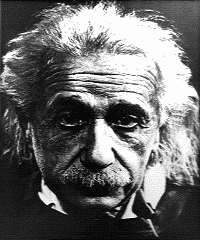 EINSTEIN'S LEGACY
EINSTEIN'S LEGACY EINSTEIN'S LEGACY
EINSTEIN'S LEGACY
Indeed, Einstein's Nobel Prize was not awarded for either one of his relativity theories - the Nobel Commitee thought them too speculative at the time. Rather Einstein won the prize for explaining the photoelectric effect. Two of Einstein's 1905 papers were on the theory of atoms and molecules, yet there were still many scientists in 1905 who did not believe in atoms or molecules !
 In 1924 Einstein received a paper from Indian physicist
S.N.Bose
that described light as a gas consisting of photons. This photon gas was a strange type of gas,
for the particles in it did not obey the commonsense statistical laws that
billiard balls do. If you randomly roll a number of perfectly elastic billiard
balls on a frictionless table, sooner or later they will all end up in one
pocket or another. If you checked by repeated experiments, you would find that
all the balls had an equal probability of falling into any one of the pockets.
But if the billiard balls behaved like photons, you would find that if one of
the pockets already had a ball in it, the rest of the balls would have a
tendency to fall into that pocket. In fact, the more balls already in a pocket,
the more likely another ball would choose to join its identical mates.
In 1924 Einstein received a paper from Indian physicist
S.N.Bose
that described light as a gas consisting of photons. This photon gas was a strange type of gas,
for the particles in it did not obey the commonsense statistical laws that
billiard balls do. If you randomly roll a number of perfectly elastic billiard
balls on a frictionless table, sooner or later they will all end up in one
pocket or another. If you checked by repeated experiments, you would find that
all the balls had an equal probability of falling into any one of the pockets.
But if the billiard balls behaved like photons, you would find that if one of
the pockets already had a ball in it, the rest of the balls would have a
tendency to fall into that pocket. In fact, the more balls already in a pocket,
the more likely another ball would choose to join its identical mates.
 Two distinguishable particles, the
red
and
blue
balls,
can occupy three states in nine different ways.
There are three chances in nine to obtain particles in the same state.
Two distinguishable particles, the
red
and
blue
balls,
can occupy three states in nine different ways.
There are three chances in nine to obtain particles in the same state.
 If these particles were indistinguishable like photons, there would
be fewer possibilities; three less than the previous case. This enhances
the probability (3 chances in 6) of obtaining photons in the same state.
Now, there is no force or attraction involved in this effect. It is just a
statistical tendency
that causes photons to prefer to travel together. This
phenomenon, developed and mathematically expressed by Bose and Einstein is what
makes a laser !
If these particles were indistinguishable like photons, there would
be fewer possibilities; three less than the previous case. This enhances
the probability (3 chances in 6) of obtaining photons in the same state.
Now, there is no force or attraction involved in this effect. It is just a
statistical tendency
that causes photons to prefer to travel together. This
phenomenon, developed and mathematically expressed by Bose and Einstein is what
makes a laser !Although Einstein did not invent the laser his work laid the foundation. It was Einstein who pointed out that stimulated emission of radiation could occur. He used his photon mathematics to examine the case of a large collection of atoms full of excess energy and ready to emit a photon at some random time in a random direction. If a stray photon passes by, then the atoms are stimulated by its presence to emit their photons early. More remarkably, the emitted photons go in the same direction and have exactly the same frequency as the original photon ! Later, as the small crowd of identical photons moves through the rest of the atoms, more and more photons will leave their atoms early to join in the subatomic parade.
All it took to invent the laser was for someone to find the right kind of atoms and to add reflecting mirrors to help the stimulated emission along. Remember, the acronym LASER means Light Amplification by (using Einstein's ideas about) Stimulated Emission of Radiation.